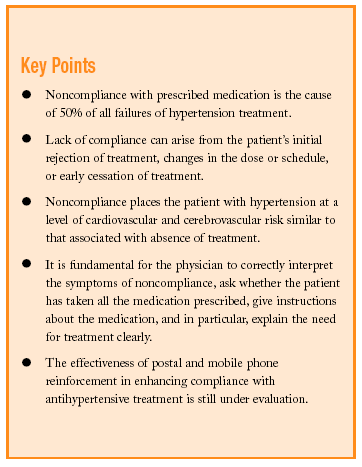Noncompliance with prescribed treatment is a well known phenomenon especially in chronic diseases, although its clinical consequences are not often assessed appropriately. The apparent safety of appropriate compliance with treatment in patients who are included in clinical trials has perhaps been one of the reasons why health professionals have failed to analyze in sufficient detail the impact of noncompliance on health outcomes.
The VI Report of the Joint National Commission on High Blood Pressure in the USA noted that only 27% of all patients with hypertension reduce their blood pressure to 140/90 mm Hg, and these poor results have been attributed mainly to noncompliance.1 Canadian and European studies reached similar conclusions, and established that noncompliance with prescribed treatment is responsible for 50% of the failures of treatment for hypertension.2,3
Compliance is understood to be the extent to which the medication actually used matches the pharmacological treatment prescribed. Lack of compliance can thus arise from the patient´s initial rejection of treatment, changes in the dose or schedule, or early cessation of treatment. Noncompliance with antihypertensive treatment increases the risk of morbidity and mortality from cardiovascular disease. Restoring treatment can on occasion cause adverse effects such as tachycardia if calcium antagonists are used.
Premature cessation of pharmacological treatment is more frequent in asymptomatic diseases that are not imminently life-threatening, as is the case with hypertension. This form of noncompliance places the patient at a level of cardiovascular and cerebrovascular risk similar to that associated with the lack of treatment.
For compliance to improve, problems that can interfere with compliance must be detected in a timely fashion. Although self-administered tests and checklists for self-reporting exist it is best to aim for effective communication and empathy during consultations, based on the classical model of self-change.4 Predisposing factors can be related with the patient, the characteristics of his or her hypertension, the usually silent nature of this disorder, the complexity of the therapeutic regimen (the best is the enemy of the possible), problems in the patient's milieu, or problems with the health care system. The physician's actions should be guided by a realistic view of the circumstances, and messages need to be backed up with constant reinforcement and appropriate follow-up. If the health professional is able to establish, in collaboration with the patient, a shared, realistic treatment plan, the chances of success will be greater.5
Increasing patients' knowledge about hypertension is a necessary although not sufficient condition for improving compliance. Another basic need is for the physician to correctly interpret the symptoms of noncompliance. Thus the physician should ask whether the patient has taken all the medication prescribed, give instructions about the medication, and in particular, explain the need for treatment clearly.6 Increasing the frequency of appointments, using active outreach systems for patients who miss appointments, and improving accessibility are all strategies that contribute much to increasing compliance with treatment in patients with hypertension. Any postal system, Short Message System (SMS)--based technology or other type of approach may serve to provide support and reinforcement for these measures.
The article by Márquez Contreras and colleagues examines an original way to try to improve compliance with
treatment for hypertension by sending messages and reminders over the patient´s mobile phone. One of the factors that might explain the absence of significant differences between the intervention and the control groups is the high rate of compliance in the latter group. The problem then is how to harmonize the internal validity of clinical trials with external validity. If we know that the mean rate of noncompliance with treatment for hypertension in Spain is 45%, the question we should be asking is this: why was the rate of noncompliance in this control group below 15%? The reason can easily be imagined. The participants did not represent "average" family doctors, probably because these professionals are little inclined to participate in this type of study. Physicians who take part in such research are likely to be interested in hypertension and cardiovascular disease, to be more highly trained, and to be more highly motivated than usual. In a way, what this study tells us is that even in a subgroup of especially motivated physicians, the use of SMS technology did not contribute much to the management of their patients' hypertension. Nevertheless, it is a highly pertinent project as the use of SMS technology can be expected to continue to spread
throughout the population. This may mean that the use of these communications systems will become more common--hence the need for further research into their potential to improve compliance with pharmacological treatment for hypertension. We should not neglect the opportunity to evaluate this and other ingenious, novel and original methods for enhancing compliance with
treatment for hypertension and reducing mortality from cardiovascular diseases.









